In the United States, water can feel like an abundant resource given its sufficient accessibility, however, less than 1% of Earth’s water is drinkable and available for human use. Earth’s surface contains 98% salt water and 2% freshwater; much of the freshwater is stored in glaciers or underground reservoirs. 42
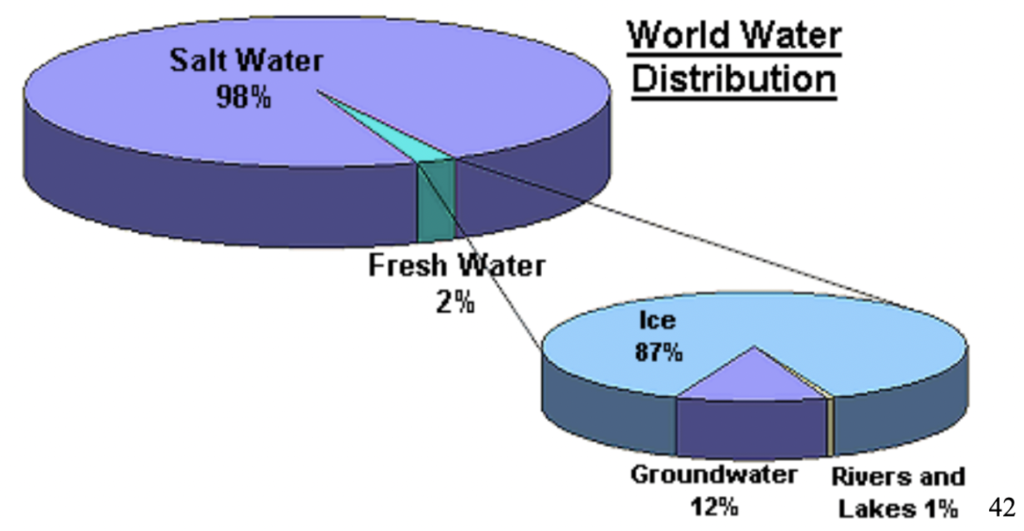
General Information on Water Usage:
Water is used more often than you think in direct and indirect ways.
Direct Water Usage
- Drinking
- Cooking
- Cleaning
- Sanitation
Indirect Water Usage
- Growing food
- Producing clothing/ steel & other essential products
- Electricity generation (hydro and crude oil extraction/ refining)
- Fire suppression
- Public swimming pools
- Upkeep public parks
- & much more
According to the EPA, the average American household uses 300+ gallons of water per day, 70% of which occurs indoors (excludes lawn care and external activities).33 Agriculture accounts for ~70% of the world’s consumption of water. Rapid global population growth and its subsequent urbanization aids the exponential use of water-intensive irrigation methods.43
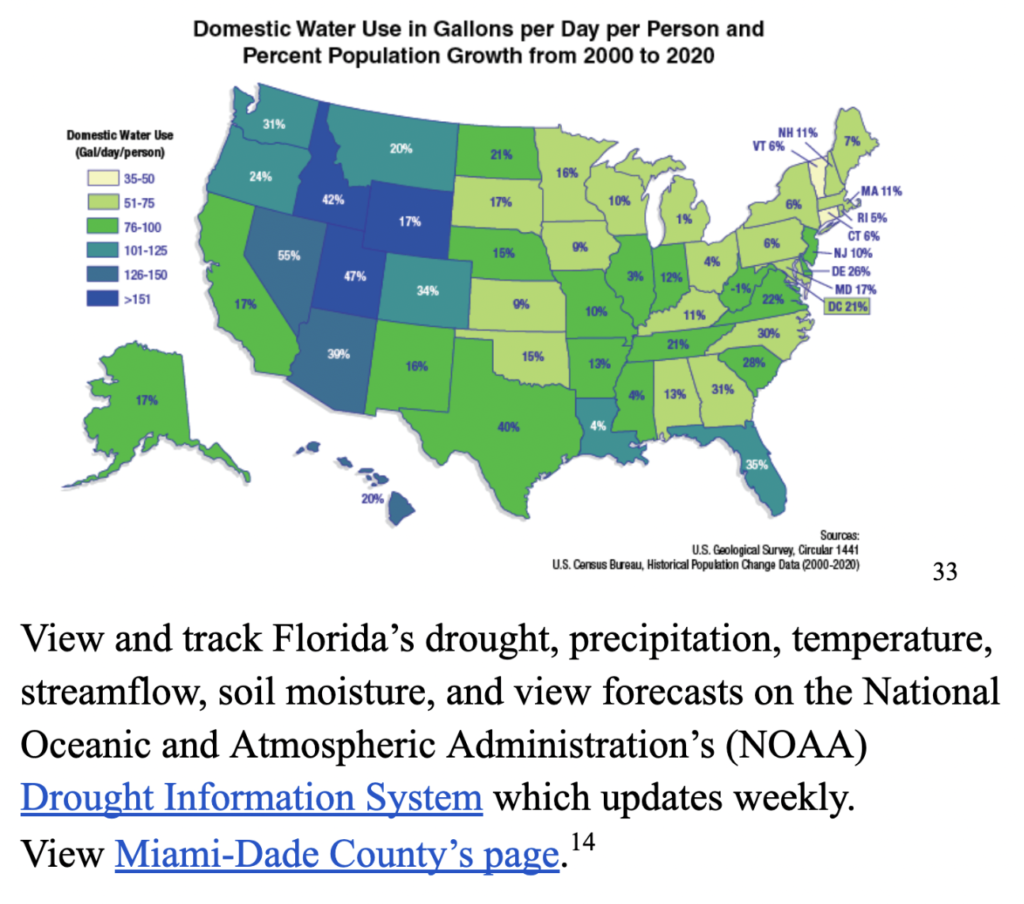
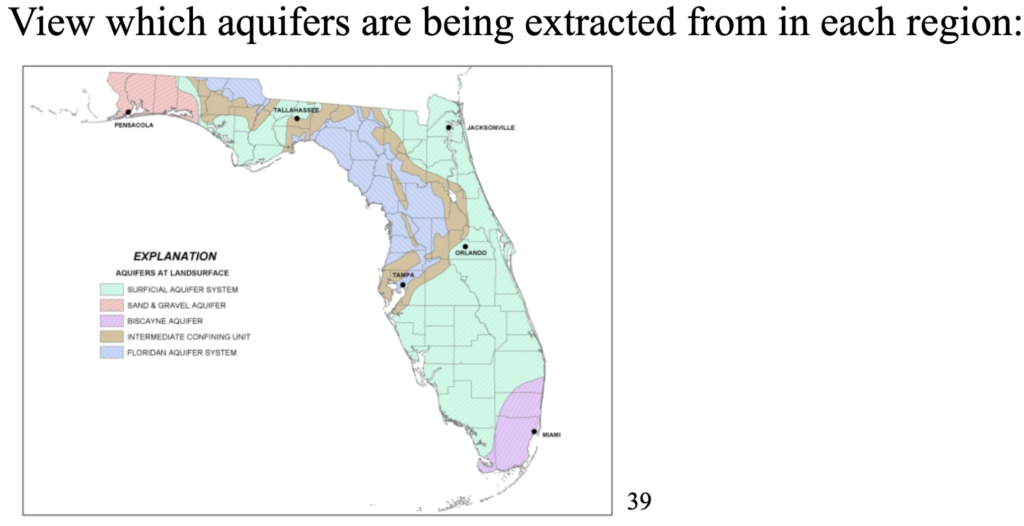
Why are we concerned about water?
Water is a renewable resource that is essential for all life. It is embodied around the world in 3 forms.
- Liquid such as the water you drink
- Ice such as the polar ice caps
- Gas such as evaporation or moisture in the air
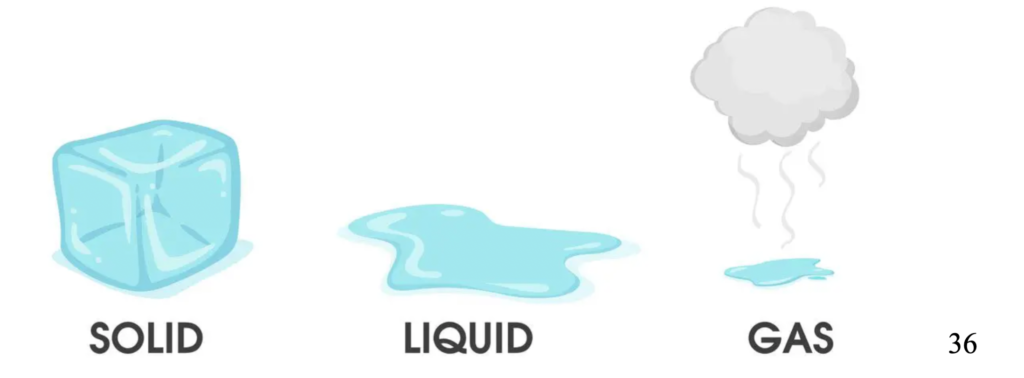
Water cycles through these forms – liquid water evaporates from surface water and trees into vapor. It condenses into clouds and precipitates to the ground as rain, snow, or hail.36 37
Click to learn more about the water cycle: 36

Threats to our water: 36
- Floods and surface runoff lead to freshwater contamination
- Warming temperatures and glacial/ permafrost melting is creating more saltwater, making less water available for consumption
- Droughts are becoming more common leading to over-extraction of water
- Can lead to
- Saltwater Intrusion
- Environmental, political and social stress.
- Can lead to
- Habitat destruction due to human activity such as population growth and urban development, changes water infiltration rates because of impermeable surfaces. This disrupts the natural flow and distribution of water
- The distribution and usage of water resources is unequal – leading some to abuse water by using it in non-essential ways.
A Global Update: Water’s Impact on Climate Change
Water bodies and ocean currents are essential for monitoring land temperature as well as regulating our climate. Studies have suggested that a crucial ocean current, the Atlantic Meridional Overturning Circulation, a large ocean circulation that brings warm water from the tropics into the Atlantic jet stream, is going to collapse. As water travels to the north it gets colder and saltier. The more salt in the water the heavier it is and it sinks to the bottom to move southward with the current. It delivers nutrients, regulates sea levels and weather patterns. According to NOAA and scientists, the current has likely weakened due to human driven climate change – as temperatures rise, freshwater ice melts and decreases the overall salinity of ocean water. This disrupts the natural process of the circulation which could result in cascading environmental effects, altering global temperatures and weather patterns.32
This page will examine the important problems facing the water sources of Miami-Dade County.
Miami’s Specific Challenges
Habitat Loss & Subsequent Loss of Ecosystem Services
Most of Miami-Dade County consists of wetlands, one of the most endangered environmental habitats. Wetlands are essential to our globe as they are highly productive habitats and play a vital role to the water cycle and global ecosystems. Wetlands provide shelter and nursery areas to key aquatic and terrestrial species that offer commercial and recreational value. Wetlands increase biodiversity within the ground, air, and water, however, a declining presence of animals in Florida’s wetlands indicates an unhealthy habitat. 15 21 34
Some species that call wetlands their home are 15 21
- Species: shellfish, fish, turtles, alligators, hippopotamuses, beavers, manatees, salamanders and more.
- Birds: Anhingas, Stork, Herons, Egrets, Gulls, Ducks, Eagles and more
- Plants: Mangroves, Buttonwoods, Seagrasses and other salt-tolerant trees and plants.
Economic & Environmental Value of Wetlands 15 21
- Acts a ‘sponge’ and soaks up excess amounts of water (such as from flooding) by as much as 60%
- Buffers the land from storms & wind and absorbs wave energy from the ocean
- Prevents property loss for citizens and the municipality
- Functions as a natural reservoir that can store more than one million gallons of floodwater
- Purifies water to be a desirable quality
- Provides freshwater in a saltwater heavy environment
- Sequesters carbon dioxide
- Helps manage air quality
- Stabilizes soil & sediments to preserve habitats, resources
- Decreases the likelihood of erosion
- Acts as wintering grounds for migrating species


How South Florida’s Land Has Changed
When Europeans first settled North America, there were approximately 200 million acres of wetlands. Now over half the US’ wetlands have been drained or filled to accommodate urban development. 15
Florida is one of the fastest growing states in the Southeast Region of the US. In general, resident migration increased by 1.6% in 2023.5 Moreover, growth projections for the City of Miami from the International Sales Group expect that big corporations are moving their headquarters to the area, which will drive the city’s population upwards.16 Since 2020, 180 companies have agreed to move their businesses to Miami and more notable CEOs such as Jeff Bazos, Ken Griffin and Carl Ichan will be planning to move their operations to the city. This will likely stimulate further development in the area, leading to more inflated housing prices and likely further environmental degradation.16
Business people are attracted by the good weather conditions and sun. This is ironic as major corporations are responsible for significant environmental degradation, greenhouse gas emissions, deforestation, water pollution and much more. Regardless, the International Sales Group anticipates that this migration will be a long-term trend. This is good because it will possibly address the housing affordability crisis and fill units, however there are still immense consequences for local residents. 16
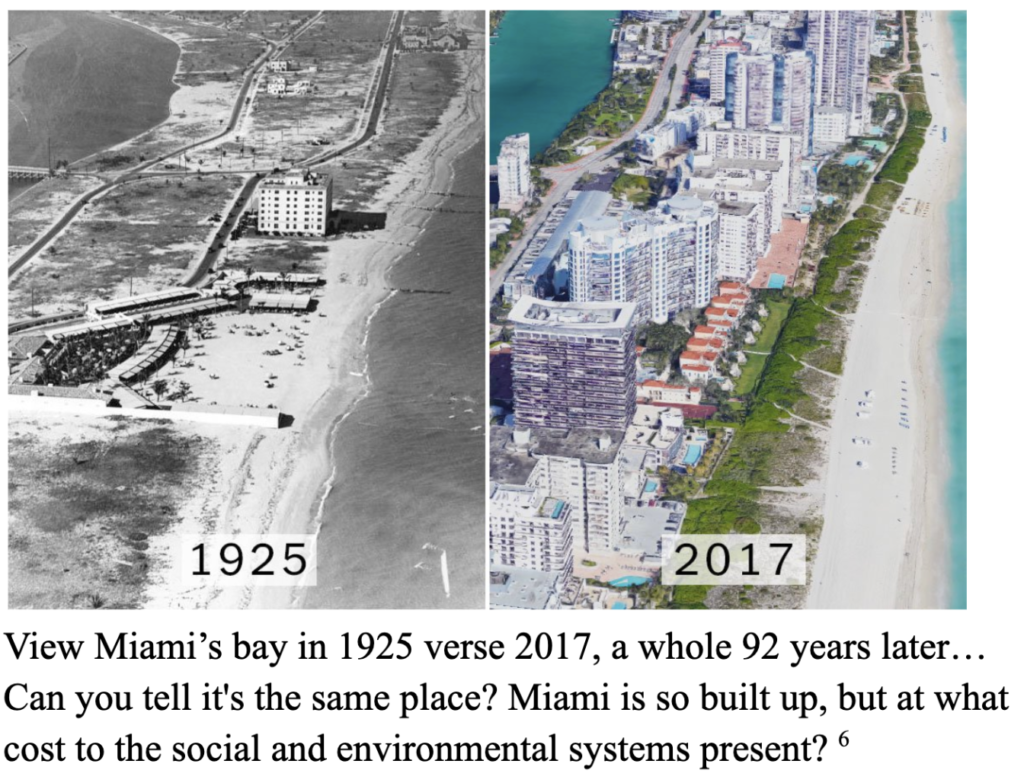
Biscayne Bay
For a refresher on basics of the Biscayne Bay, click here.
Beyond being home to two national parks and key ecosystems, Biscayne Bay offers the Miami-Dade County and surrounding areas many resources including… the basic component to life, clean freshwater. 38
Clean Water
As noted above, freshwater is needed for life however it is scarce on this planet. Biscayne Bay is pivotal to Miami as its mangroves and seagrass habitats offer the service of natural water filtration and replenishes Miami-Dade’s aquifer and groundwater supply. Canals that feed into the bay provide more than half of the bay’s freshwater. The northernmost canals contribute the most to freshwater supplies, where the most notable seagrass losses have occurred, destroying economically important fisheries for shrimp, lobster, and other fish species.2 38
The Bay provides habitats to more than 30 endangered species and soon to be endangered species such as the Smalltooth Sawfish and the West Indian Manatee. It also supports more than 100 species important to recreational and commercial fisheries. The declining health of the bay and estuary jeopardizes Miami’s ability to meet the needs of their citizens and tourists.38
Biscayne Aquifer is a shallow, porous limestone rock formation that provides freshwater to urban and agricultural areas. It is recharged by rainwater that eventually flows into the Florida Everglades. Moreover, the bay supports the boating and water recreation industry, generating more than $6 billion per year of economic benefit.2 4 38
Decline of seagrass habitats in the bay 2 4
– Barnes Sound and Manatee Bay basins → ~ 93%.
– Coral Gables →~85%.
– Rickenbacker Causeway → ~66% to 89%
Optional reading for more on Biscayne Bay
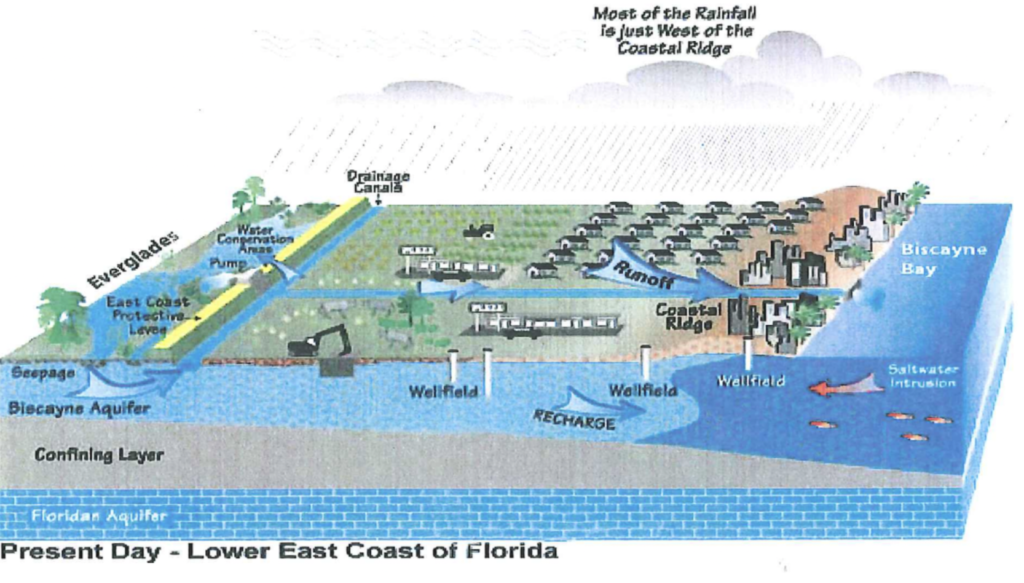
In recent decades, Biscayne Bay has been experiencing a significant decline in water quality and habitat health. According to an online survey, residents of Miami-Dade County show a lack of concern due to the incorrect perception that the estuary is “moderately healthy.” 13 26 40
Threats to freshwater in the Bay 13 26 40
- General hydrological changes (natural and human created)
- Poor water management practices
- Degraded water quality, contributed to by
- The aged water infrastructure
- Runoff from the mainland that contains unnatural chemicals and high levels of nitrogen which leads to
- Algal bloom
- Decrease in the health, diversity and distribution of the plants
- Land Development
- Sediment loading from shoreline degradation
- Solid pollution
- Mangrove habit declines due to commerce and tourism interest
These factors have forced local authorities to alter the habitat immensely by partaking in…
- Dredging and filling activities
- Constructing major drainage canals
- This has led to flooding as rainwater infiltration rates have been altered
Since 1890, 20%+ of the North Bay has been filled and replaced by 30 islands and 6 roadways/ railway. The Miami River and North Bay canals have been dredged to improve navigation.
Development
Urban development has economic advantages however poses many negative externalities. 3 key impacts are…
Pollution: Local Current Attitudes Towards it
According to an online survey of more than 1,000 Miami-Dade residents from 2022, locals think about and value Biscayne Bay and the other neighboring water bodies. Floridians interact with natural and unnatural water bodies regularly and in a variety of ways such as enjoying the beach, going boating, or fishing. The survey concluded that Miami residents were concerned about the highly visible environmental challenges such as plastic pollution but the slower-moving threats like sea level rise, habitat degradation and algal blooms were not as cared about. Moreover, participants were more concerned about the loss of coral reefs, a well known habitat with widespread appeal, rather than the more productive, less popular habitats such as seagrass.40 This evidence shows a significant disconnect between the science & statistics and the locals’ perceptions of pollution. More awareness and advocacy is needed in order to combat all key pollutants.
PortMiami
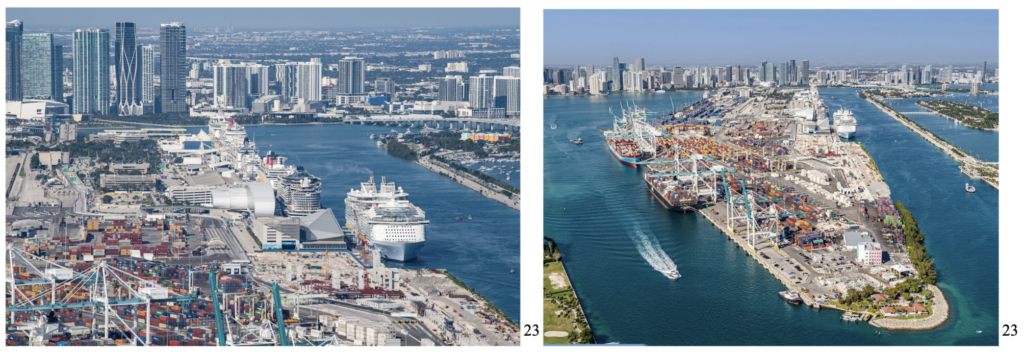
Port Miami, located within Biscayne Bay, is a resource for the City of Miami and Miami-Dade County. Port Miami acts as an economic generator, as it was recognized as the global “Cruise Capital of the World,” contributes $43 billion annually to the local economy, and supports more than 334,500 jobs in South Florida. The seaport experienced a 6.97% increase in cruise passenger totals compared to its previous record of 6,823,816 passengers in Fiscal Year 2019.1 It also acts as a global gateway for cargo into North America. It links the world’s global markets to the United States as it has easy access to the north-south and east-west trade lines.23 44

Port Miami welcomed 7,299,294 cruise passengers in 2023, celebrating its busiest cruise year in its history. Pictured above is the seaport’s impact on Miami-Dade and South Florida. TEU stands for twenty-foot equivalent unit. 7 23 24
Sustainability at the Port
Boats are essential to modern society as their commercial shipping is key to global economies. There are pressures on the commercial shipping industry to decarbonize as these vessels account for one billion tons of greenhouse gasses a year, or 2.9% of global emissions, however cruise vessels are experiencing no push back. 7
Post the COVID-19 pandemic, cruising is a very popular vacation option. However the industry does not get acknowledged for the toxic sulphuric gasses it emits into our air and ocean. One cruise ship spews out the equivalent to 13 million cars worth of sulphuric gasses and more soot than a million cars, according to US government data from the Cruise Ship Report Card. 44
According to Port Miami’s website, the port is “committed to adopting policies that support sustainability and ensure earth-friendly operations.” Learn more about their Solutions in the Green Ports program 7 44
Eutrophication & Fish Kill

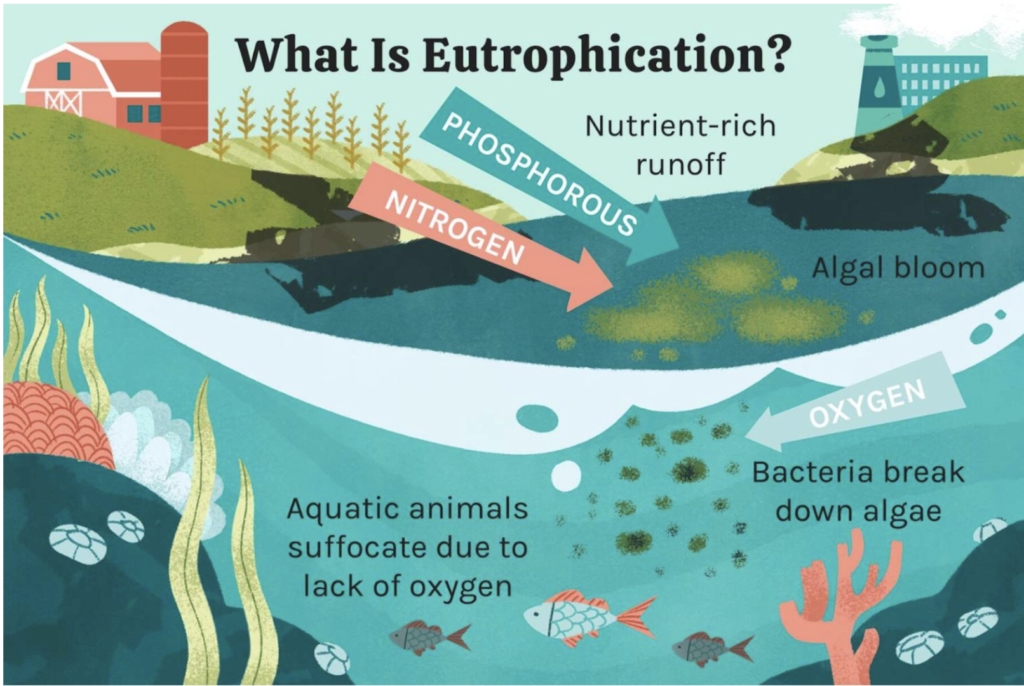
Eutrophication is the excessive growth of algae or nuisance plants in a body of water typically a result of over-nutrient enrichment. Nutrients are dissolved into runoff from man-made powered sources like fertilizers for agricultural and ornamental plants, sewage, or factory waste. This leads to unnatural levels of chemicals like nitrate and phosphate entering our water systems.
Nitrate and phosphate in small concentrations are needed for all plants and algae to grow, however when unhealthy amounts of these nutrients are present, plants and algae grow at an undesirable rate and take over environments.
Eutrophication is also called “algal blooms”, and it has adverse effects on aquatic ecosystems. The excessive presence of nutrients leads to overgrown algae. This algae covers sunlight, halting the productivity of deeper organisms and can suffocate or starve organisms. Key areas that experience this are Biscayne Bay & local parks. 12
Learn more about eutrophication and its associated impact such as fish kills here: the Florida Museum, Miami-Dade County’s website, Local 10 News
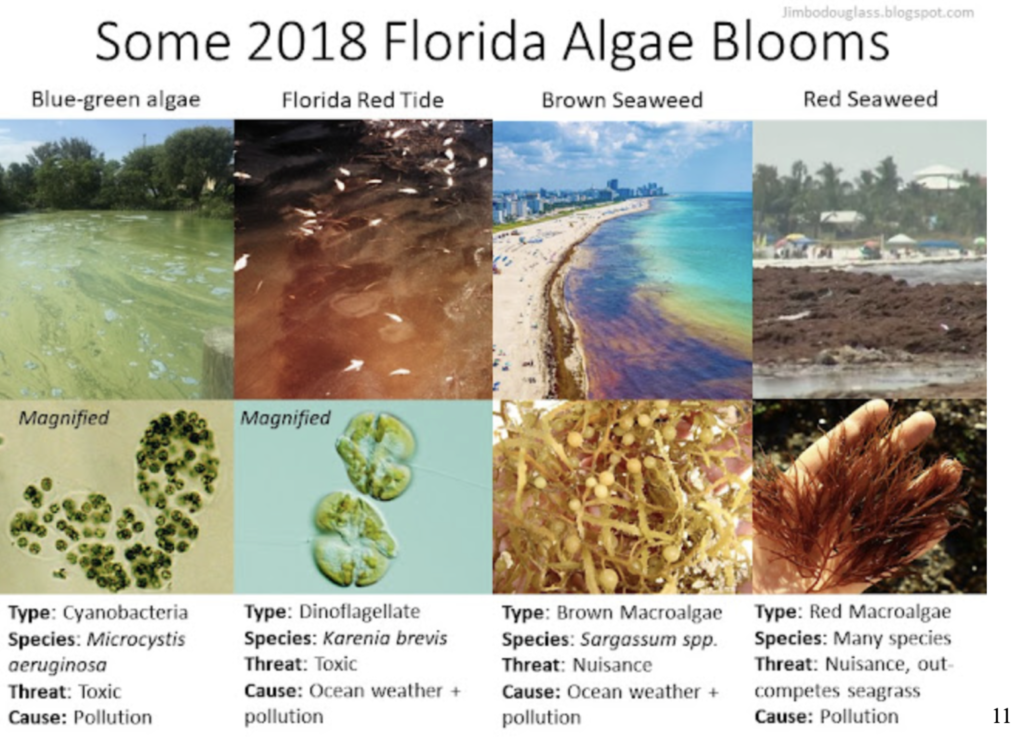
Sea-Level Rise and Flooding
Miami is one of the lowest-lying municipalities in Miami-Dade County. The county is 6 feet or less above sea and Biscayne Bay is roughly 3 feet below sea level. 6
To put that into perspective, the United States has an average elevation of about 2,500 feet (763m) above sea level. 25
In recent years, due to sea level rise, people living and working in Miami have experienced more impacts from the full-moon high tides. This phenomenon is when the gravitational pull of the sun and the moon on Earth causes oceans levels to be higher than usual.
More associated impacts of sea-level rise are listed below:
- Saltwater seeping into the fresh-water supply
- The erosion of porous limestone rock, which supports Miami’s heavy buildings
- Stormwater that has pooled into the streets, sidewalks and buildings during storms has threatened existing buildings and infrastructure
These impacts cannot be stopped by Miami’s sea walls and will get increasingly worse with climate change which has led to more intense and frequent rain falls over short periods of time. Examples of this are hurricanes, tropical storms etc. effects that are worsened by a lack of effective urban planning and proper flooding infrastructure.6
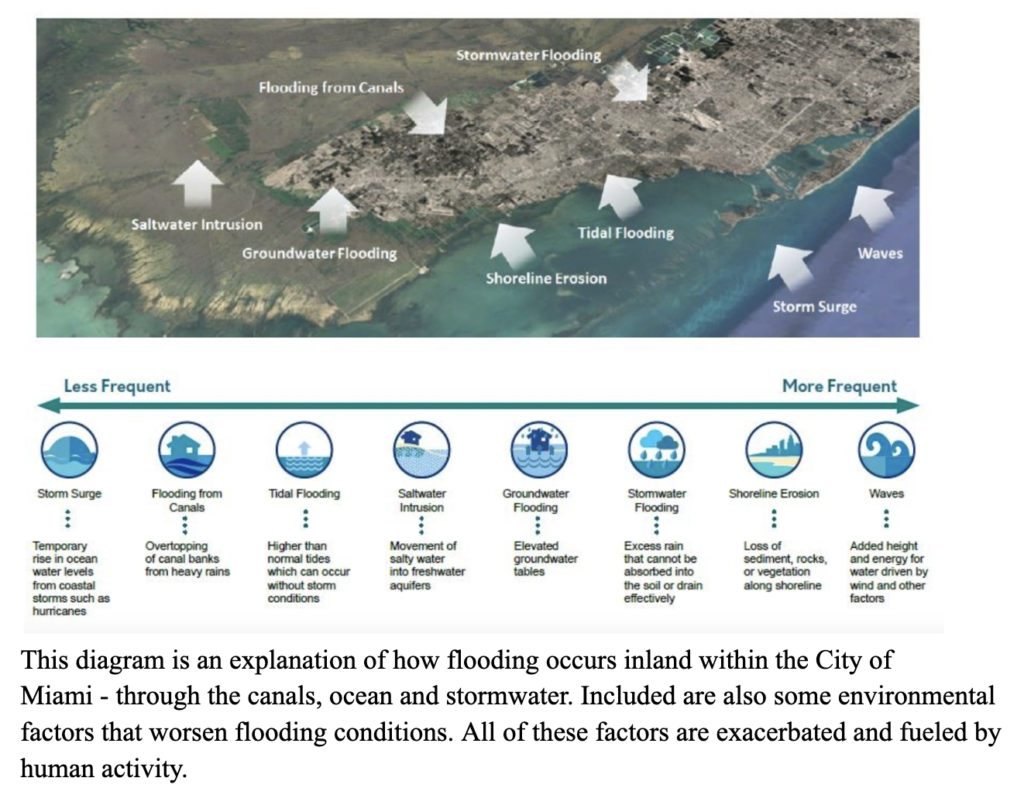
Flooding & Social Injustice
As touched upon briefly in the Introduction to Miami-Dade, income inequality is high in the county. Extremes of wealth and income are strongly associated with race and in an interconnected way, flood risk. Just like in a lot of coastal cities, homes within close proximity to the bay or beach are the most desirable and expensive.6
Research has showed that the following percentage breakdown of residents living in areas with high flood and storm surge risks in Miami-Dade County. 6
- Coastal flooding 6
- 59% were white
- 30% were Latino
- 8% were non-Latino black
- Inland flooding 6
- 41% were Latino
- 20% were non-Latino black


Miami’s Current Solutions:
Conservation
Conservation efforts have the potential to transform ecosystems for the better. Nature conservation is the act of protecting natural systems against potential harm. This can include restoring habitats, enhancing ecosystem services and more.
The idea of Conservation economics is to understand the costs and benefits of sustaining natural ecosystems to accomplish widespread and lasting efforts. This method would lower costs and reveal direct and non-direct benefits for the natural, social and economic environments. 28
Examples of Effective Conservation Methods
- Community Engagement Conservation
- Baynanza: An annual celebration of Biscayne Bay run by Miami-Dade County. It includes Biscayne Bay Cleanup Day in April where thousands of community members and local business owners volunteer to collect tons of garbage from areas along the bay.
- View tips for citizens to implement conservation at home, to do their part in protecting the Biscayne Bay.
- Political & Governmental Measures to Achieve Conservation
- Fertilizer Regulations: The Florida-friendly fertilizer use on urban landscapes ordinance, adopted in April 2021, bans the “use of nitrogen and phosphorus fertilizer during the summer rainy season, May 15 – October 31.” This is an example of leveraging policies to work towards preventing eutrophication and potential environmental harm.
- Wellfield Protection Areas: In order to prevent contamination of Miami-Dade County’s groundwater, the government restricts land use and activities that may generate pollutants to maintain an affordable drinking water supply. The efforts circulate around zones that are in close proximity to public water supply wells.
- Economic Investment: Miami-Dade County is investing $13.5 million to protect Biscayne Bay. Read more to hear about how the funds will be allocated.
- Fundraisers: Residents can purchase a Protect Biscayne Bay license plate for $33 to both raise awareness of the challenges within the bay and fundraise.17
- Non-Profit Conservation: View Florida’s State Wildlife Action Plan38
Economic & Business Incentives
- Generally reducing water bill prices
- Insurance may offer premium reductions for properties with efficient water systems
- Government Incentives
- Rebates to promote water conservation
- Tax credits for installing water-efficient appliances
- The WaterSense program, which is sponsored by the EPA, offers certifications for water-efficient products and resources to implement water-saving solutions
- Offering like the Domestic Wastewater Operator Certification Program supported by the Florida Department of Environmental Protection and other municipalities across the US. Wastewater Treatment plant operators can better prepare them self and continue their education to better their ability to support our water cycle
While these solutions do not solve the consumerist ideology towards water, they do offer an actionable way to meet businesses and municipalities to make a profit while adding environmental value to the equation. 30
Seawater Desalination
Seawater desalination is the process of removing salt and other minerals from water in order to transform the water into a state suitable for human consumption, irrigation, or other purposes. The water is pumped into a membrane that filters out the impurities, creating freshwater. A common desalination method is reverse osmosis. These methods can be done with brackish water, treated wastewater, and agricultural runoff. 9
South Florida is leveraging this technology to turn brackish and salt water into drinking water as their population and subsequent needs continues to grow.
The cost of seawater desalination is substantially more than traditional treatments for brackish water. This is a limitation to this solution being utilized globally, as it is too expensive for widespread implementation. There is financial assistance that municipalities can apply too, however it is clear the treatment methods are not the most efficient solution to challenges pertaining to water. Moreover, the desalination efforts are not expected to reach the 2030 demand for water. 8 10
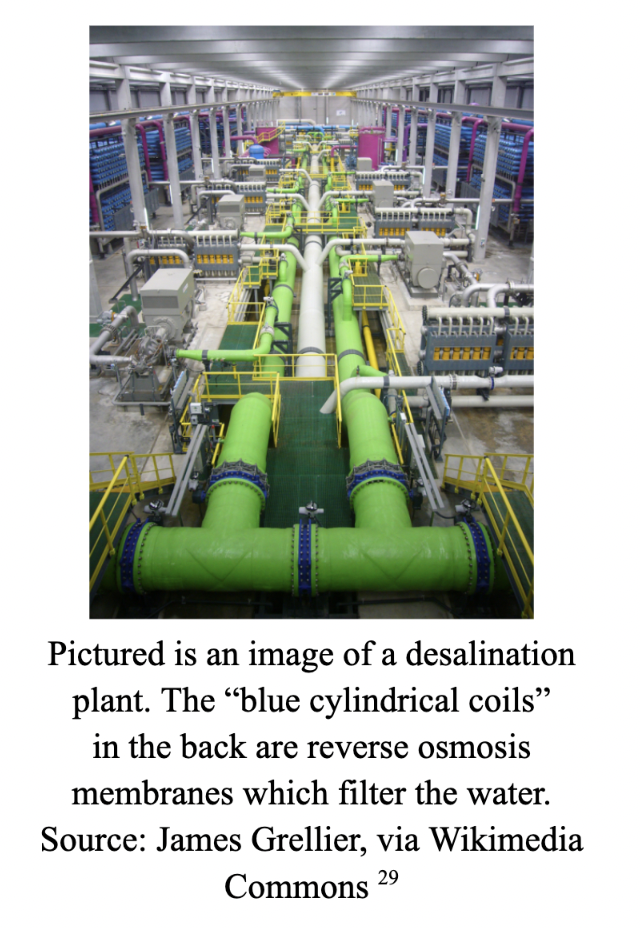
Review Miami-Dade’s current solutions in their Water Conservation Plan & Water Supply and Treatment center operations.
Conclusions
Based on the challenges pertaining to water and their respective solutions, it is clear that the best way to ensure that humanity has access to clean, safe and accessible drinking water is that people do their best to invest in conserving the existing water resources.
Conservation aligns with this examination’s explanation of sustainability, however desalination does not as it lacks the ability to fix the environmental problems faced globally. Desalination acts as a band aid solution, or a temporary fix that does not effectively address the root of the issue. Efforts like desalination can be momentarily helpful but should be coupled with solutions that directly address components of the problem, such as water conservation.
Optimism should be maintained because there is immense potential for collaboration among stakeholders to achieve meaningful progress in this issue.
View Miami-Dade Sewage – https://twitter.com/miamidadewater?lang=en
Relevant Stakeholders
Habitat Loss & and Clean Water
- Greater Miami Convention & Visitors Bureau
- Miami-Dade County Tourist Development Council
- Pelican Harbor Seabird Station, Inc.
- National Parks Service
- Florida Fish and Wildlife Commission
- Miami Waterkeeper
- The Nature Conservancy
- South Florida Water Management District
- Miami-Dade County Department
- Division of Environmental Resources Management
- The Biscayne Bay Management Committee
- & more
Port Miami, Pollution & Eutrophication
- The City of Miami
- Florida’s Exporters
- Large Corporations who export and import goods in the harbor
- Industries including the fashion, agricultural and automotive industries
- Other states that receive goods which pass through this port
- Cargo Ship Companies
- Cruise Ship Companies such as Carnival Cruises, Royal Caribbean, Princess Cruises etc.
- Those who cruise for vacation
- Owners of the port
- Those who rely on tourist who enter Florida through the port
- Restaurant owners, small business owners, cab services, hotels, etc.
- American Association of Port Authorities
- The Mayor’s Office
- Miami-Dade County Department
- & more
Sea-Level Rise and Flooding
- Residents of Miami from all income levels & locations (coastal and inland)
- Local Businesses
- Contractors who must build structure to withstand floods
- Business consultants
- Corporate management teams of local corporations
- Beach management
- City of Miami’s government
- Building Dept.
- Civic Service Board
- Division of Emergency Management
- Finance Department
- Miami-Dade County Department
- Department of Public Works
- Fire Rescue
- Water and Sewage
- Emergency Management
- Parks, Recreation and Open Spaces
- Solid Waste Management
- & more
Limitations & Barriers to Solutions
Political Limitations
In America, issues pertaining to climate and the environment are political. As mentioned in previous parts of my website, key leaders and much of Florida’s population are climate-change deniers. This means that it can be hard to get funding and engagement from both the governmental and public sectors.
The state of Florida, led by Governor Ron DeSantis has refused to acknowledge the urgency of climate challenges and has created contradictory initiatives designed to solve short-term issues. Specific clear barriers, created the the DeSantis team, are:
- The dismantling of good climate policies at the start of his time in office
- The banning of the terms “global warming” and “climate change” within state agencies, commissions, and departments
- The legislation which allows certain kinds of fracking that have been banned in other areas
- The approved exploratory oil drilling in the ecological sensitive areas such as the Apalachicola River Basin
- DeSantis’ failure to object to recent federal permits which granted corporations permission to drill in the Gulf of Mexico
Financial Limitations
Financial limitations to solutions are significant as noted above. The financial feasibility of solutions directly relate to whether the government will support the given initiative, if a grant can be obtained, or if there is enough reward to warrant an investment. The current leadership in Florida has a track record of poorly allocating funding for environmental purposes.
Societal Preferences
In terms of habitat restoration efforts, there is one key limitation.
The cultural and societal service the beach offers – viewing pleasure. Biscayne Bay specifically is a major habitat that must be restored and supported physically by vegetation. Habitat loss has occurred due to the development of expensive homes on the coastline. Not only does this degrade the quality and value of the shorelines, but it also stands as a barrier to implementing better environmental support. Many of the individuals who live near the ocean want an unobstructed view of the ocean, but this view comes a millions of dollars worth of damage to their homes, the shorelines, and inland areas of the city due to the lack of storm buffers and essential habitats.
Broad List of Assets
- Biscayne Bay Foundation
- Miami Waterkeeper
- The Sierra Club Miami Group
- National Parks
- https://erams.com/water-connect/home/miami-fl-main/
- Division of Environmental Resources Management
- Sea Port
- Sea Port Association
- & possibly more
